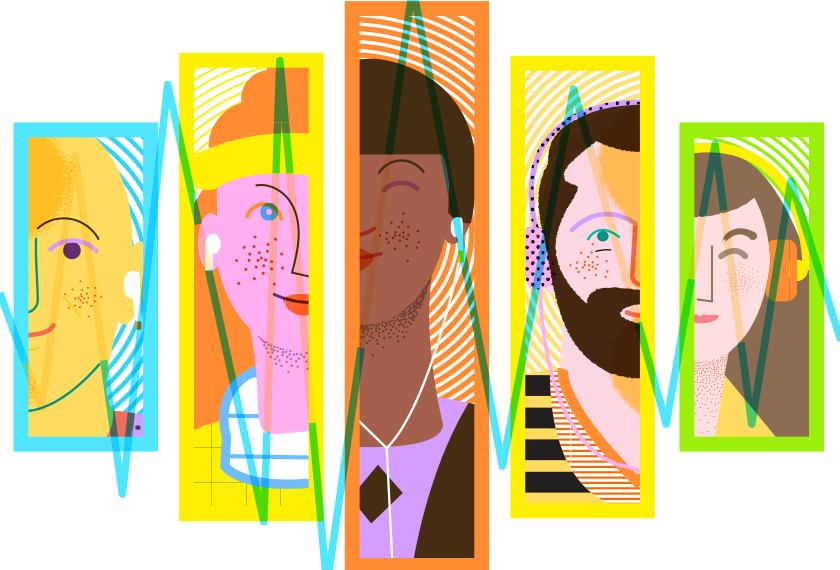
No, no, go ahe—” “Oh, no, I can wait, what were you—” “I just wanted to say—.” “Oh.” (Two beats of silence.) “I’ll just put it in the chat.”
If you are in a lot of hybrid meetings, you’re familiar with the awkward overlaps and pauses that can riddle those digital interactions. The chat thread and the hand-raise function help, but as (some) people return to work together in person, side conversations in the on-site conference room and office setups that aren’t equipped for a hybrid experience add to the complexity.
To understand how to make meetings flow more naturally, Microsoft researchers are studying the science behind interruptions and looking at how leaders can facilitate better communication for all meeting participants, regardless of locale.

“You could clearly find patterns of people taking long turns or interrupting somebody else on a regular basis.” —Sean Rintel, Microsoft principal researcher in human-computer interaction
A Map of Interruption Patterns
Research into turn taking isn’t new—scientists have long studied how interruptions or snippets of encouragement shape our verbal interactions. The rise of the telephone prompted early statistical research into the subject , and scientists have since investigated everything from how plain-tailed wrens create a duet to whether bonobos engage in cooperative conversational back-and-forths. (They do.)
In a recent study, a group of Microsoft scientists that included Sean Rintel, a principal researcher in human-computer interaction, explored whether it was possible to map out and evaluate interruptions by analyzing anonymous meeting transcripts. Could they use the system to characterize communication styles and behaviors?
The team used a custom app to analyze anonymous transcripts, assigning speakers numerical IDs and tracking metrics like the number of times each person spoke, the duration of their speech, and the number of words they uttered. They then mapped that data into a timeline graph to make it easier to spot patterns. The data revealed that, not only did it appear to be possible to categorize turn-taking behaviors, Rintel says, but “You could clearly find patterns of people taking long turns or interrupting somebody else on a regular basis.”
The tricky part is understanding context. Something that might seem like an interrupter being particularly dominant might also be the speaker ceding the floor. (Imagine a teacher giving a lesson and asking students to jump in with questions. Or a colleague struck with nerves in front of a room who gets bailed out by a helpful co-worker.) “Depending on the kind of meeting it is, you may be able to make judgments about whether or not it’s inclusive or effective,” Rintel says.
Rintel points out that this research is in its infancy, but in the not-so-distant future, these systems could lead to data dashboards that business leaders could combine with training to evaluate inclusion in meetings. If you ran a series of allyship seminars, for example, you might use this approach afterward to determine if the number of speakers in a meeting changed. Would competitive interruptions drop? Would people at home get comparable speaking time to those in person?
“Ultimately what would be really interesting here is giving companies, teams, and organizations the opportunity to run experiments themselves,” Rintel says. “Helping teams understand their own processes so they can work better in ways we can never anticipate.”

Attendees reported that the meeting with spatial audio felt more interactive, and that it increased the perception that they were sharing the same space.
The Promise of Spatial Audio
Another issue with hybrid meetings is the audio setup. When we meet in person, we have the benefit of spatial audio—sounds originate from a specific location. Spatial audio provides clues as to who’s speaking, when it’s time to talk, and where to direct attention—clues that get lost in the flat audio of a digital meeting. So researcher Kate Nowak and her colleagues decided to investigate how adding spatial audio to 2D meetings might affect turn taking. Could it create useful context clues for participants?
To test the theory, Nowak pulled random groups of tech workers at the same company into video conference meetings and asked them to solve survival problems: one on the moon, and one in the desert. In one meeting, spatial audio was turned on; when a colleague on the right side of the screen was talking, audio would come in from only the right headphone. In the other meeting, it was turned off—the sound came through both headphones.
“The closer we feel together, the less psychological distance, the easier it is for us to take turns."
Attendees reported that the meeting with spatial audio felt more interactive, and that it increased the perception that they were sharing the same space. One said, “It was easier for my brain to figure out who was saying something.” By decreasing the feeling of distance between individuals, Nowak says, you can make it easier for them to coordinate with one another. “The closer we feel together, the less of what we call ‘psychological distance,’ the easier it is for us to take turns.”
The beauty of creating a tool that uses cues like spatial audio to improve behavior, Nowak says, is that you’re not asking someone to absorb a lot of information, internalize it, and then make the effort to change the way they interact with others. “It’s really amazing when you come across these kinds of technology solutions that change the environment so that behaviors happen more naturally and without as much cognition and effort,” she says.
Adding spatial audio could potentially keep power interrupters from unintentionally stealing the show—and without having to train them to change their behavior. “That’s really assisting people with technology versus saying, ‘Here, watch this like two-hour video on how to be more inclusive in meetings,’” she says.
It’s worth noting that, although Nowak did not find statistically significant differences between genders, trends suggested that spatial audio may boost women’s perception of their ability to take control of a conversation and be understood by others, which warrants “further investigation,” she says.
This research is also in the early stages, but meeting analysis dashboards and behavioral tools that help make collaborations more inclusive and enjoyable aren’t that far off—in the realm of years rather than decades. In the meantime, though, there are steps you can take to slow down negative interruptions and promote inclusion in your team meetings.
Use the Chat
This allows meeting attendees to actively engage in the flow of the conversation without interrupting the speaker. In a 2021 analysis , Microsoft researchers found that the majority of participants found chat to be a net positive. Chat can lower the barrier to contribution for introverted employees, those who feel less empowered at work, and for “users with a distracting home life, who can participate without fear of judgment.”
The key, Rintel says, is setting expectations. Chat can help folks chime in or get their questions answered—but it can also be a place for side conversations and distraction.
Designate a Moderator
Decide who is going to pass the proverbial microphone around the room and invite attendees to contribute. (Research shows that taking part in the conversation makes people happier about hybrid meetings than if they passively sit there.) You need “somebody who is paying attention to participation in such a way that they’re not cold-calling people, but they’re being really thoughtful about it,” Nowak says. Moderators should also let everyone know at the top that they’ll be monitoring time according to the agenda, and will remind speakers when it’s time to move on.
Take Breaks
Research clearly shows that too many back-to-back meetings exhaust your brain , which means that good meeting hygiene is going to be harder to maintain. Make sure everyone is primed to focus by carving out time slots between video sessions.
These simple suggestions can go a long way toward harnessing interruptions and preparing participants to fully engage. “If we design better systems and create better meeting environments, we can help people behave in ways that are more aligned with their best interests,” Nowak says. “At the core, healthy interactions are about having a feeling of connectedness and immediacy—when this happens, people are more able to relate to one another.”

